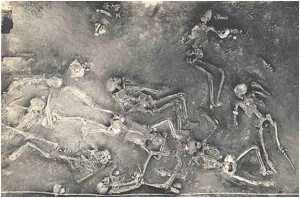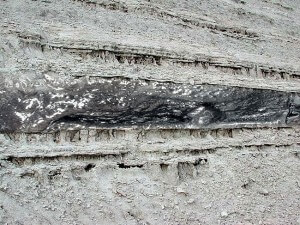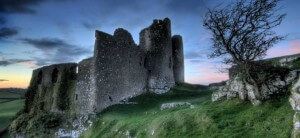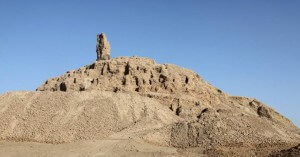 6
6

Big Pyramid as a mathematical model
 16. 04. 2024
16. 04. 2024



 6
6

 16. 04. 2024
16. 04. 2024
 8
8

 15. 04. 2024
15. 04. 2024
 1
1

 1
1

 13. 04. 2024
13. 04. 2024
 8
8
 05. 02. 2024
05. 02. 2024

Many search for the past of humanity in search of secret knowledge. Therefore, every culture of antiquity, in addition to scientific theories, is associated with many interesting, but not very convincing hypotheses. This also applies to Harapp culture.
One of the most attractive mysteries of India is Astravidya. This is what the Aryans called a mysterious weapon (in another interpretation, it is not a weapon, but an instruction to use it), which belonged to the Harappans. In an ancient Indian epic, this invincible weapon is described as follows: "It will kill the fruit in women" and "it can destroy lands and nations for generations."
The use of astravidje is accompanied by an explosion of very bright light and fire, which absorbs all living things and destroys buildings over a large area. The gods gave Arjuna, the hero of the epic, a miraculous weapon and the following instruction: "This extraordinary weapon, against which there is no defense, must never be used by you against people, if it was turned against the weak, it could burn the whole world."
This description is very similar to a nuclear bomb. The similarity between an astravidya and an atomic weapon is so striking that part of the description of the astravidya in the Mahabharata. "
Physicist Robert Oppenheimer, one of the fathers of the atomic bomb, was convinced that with his research he had gone in the same direction as the ancient Indians, and eventually mastered the secrets of nuclear weapons.
One of the chapters of the Mahabharata tells of a heavenly battle that can be considered a nuclear war:
 "… In their magnificence rose columns of red-hot smoke and flames brighter than a thousand Suns. Iron lightning, the gigantic messengers of death, turned the whole family of Vrishni and Adhaka to ashes. The bodies were burned beyond recognition.
"… In their magnificence rose columns of red-hot smoke and flames brighter than a thousand Suns. Iron lightning, the gigantic messengers of death, turned the whole family of Vrishni and Adhaka to ashes. The bodies were burned beyond recognition.
Hair and nails looked. Without a clear cause, the clay vessel disintegrated. Birds were gray. After a few hours, the food became unusable. The surviving soldiers were thrown into the water to smoke ash. "
Researchers dealing with the mythology of ancient nations often encounter paradoxical and historically unexpected abilities and inventions of ancient people. Can we believe in myths? Historians have not yet found the answer to this question.
There are many cases where the belief in the truth of myths and legends has led to incredible discoveries. Heinrich Schliemann discovered Troy on Hisarlik Hill precisely because he believed in the truth of every Illiad word (by the way, some scientists are still convinced that Schliemann did not find Greek Troy, but a completely different city).
Schliemann was helped at the time by such a small thing as the fact that the hill where Troy is located must be small, because the heroes of the Trojan War could go around the city walls three times without getting too tired. If he did not have an unshakable faith in the truth of the epic, Troy may still not have been discovered.
We can mention another case, Herodotus in his description of Egypt, telling that Egyptians mummified sacred animals, specifically the bulls of the god Serapis, and to bury such mummies they built a special temple, Serapum. The Egyptologists of the previous century unanimously claimed that this was an order invented either by Herodotus himself or by the Egyptians, because they decided to joke at the expense of trusting foreigners. Only one historian believed Herodotus, and that was the French archaeologist Auguste Mariette. He found Serapum and found the mummified bodies of sacred bulls in the temple.
specifically the bulls of the god Serapis, and to bury such mummies they built a special temple, Serapum. The Egyptologists of the previous century unanimously claimed that this was an order invented either by Herodotus himself or by the Egyptians, because they decided to joke at the expense of trusting foreigners. Only one historian believed Herodotus, and that was the French archaeologist Auguste Mariette. He found Serapum and found the mummified bodies of sacred bulls in the temple.
But is it possible to trust the Mahabharata as Schliemann and Mariette believed in their sources? Some researchers answer this question in the affirmative. In their opinion, the reason for this answer is the mysterious disappearance of the inhabitants of the cities in the Indus Valley.
Skeletons of people and animals have been found in the ruins of cities, but the few skeletons are in stark contrast to the size of the city, and leads us to assume that the inhabitants either went somewhere or were killed in an unknown way that completely and utterly "dissolved" people.
The hypothesis became even more likely when traces of a huge fire were discovered in Mohenjo-Dar. The positions of the skeletons confirm that these people did not die in the fight against the attackers. Death caught them the moment they engaged in everyday activities.
Another discovery surprised historians even more, large pieces of sintered clay and whole sheets of green glass, in which sand was turned, were found in various places in the city. The sand and clay melted under high temperature and then solidified quickly.
Italian scientists have shown that the conversion of sand into glass is only possible at temperatures above 1500 degrees Celsius. However, the technology of that time allowed to reach such a temperature only in metallurgical furnaces, but that a fire with such a high temperature would be in the whole territory of the city is very unlikely. Even today, we would not be able to do it without flammable substances.
 When archaeologists excavated the entire territory of Mohenjo-Dara, they discovered another peculiarity. In the middle of the residential part, the area of the epicenter was very clearly visible, where all the buildings seemed to be swept away by the wind. From the epicenter to the walls, the destruction grew less and less. And there is one of the mysteries of the city, the best preserved buildings on the edges of the walls, which are, however, most destroyed in the attack of the normal army, including the walls.
When archaeologists excavated the entire territory of Mohenjo-Dara, they discovered another peculiarity. In the middle of the residential part, the area of the epicenter was very clearly visible, where all the buildings seemed to be swept away by the wind. From the epicenter to the walls, the destruction grew less and less. And there is one of the mysteries of the city, the best preserved buildings on the edges of the walls, which are, however, most destroyed in the attack of the normal army, including the walls.
The damage to Mohenjo-Dara is very reminiscent of the aftermath of the Hiroshima and Nagasaki explosions, says Englishman Davenport and Italian Vincenti. At the same time, they also pointed out that after each atomic explosion at the nuclear shooting range in the state of Nevada, there were pieces of green glass in similar quantities as found in Mohenjo-Dar.
Some researchers believe that there was a highly developed civilization in India that was at a higher level than our current one. It disappeared as a result of a clash with another, equally advanced or extraterrestrial civilization, with the uncontrolled use of technology, say nuclear weapons.
Another, perhaps the most fantastic theory, claims that the Harappans made contact with an alien civilization, and as a result they received a state-of-the-art weapon for which they were not yet ready. And as a result of the misuse of this weapon, civilization in the Indus Valley has disappeared.
The ruined capital of culture in the Indian River is not the only example of the mysterious ruins burned by the "heavenly fire". These include several ancient cities in various parts of our planet, archaeologists say. Examples include the capital of the Hittite Empire, Hattush, the granite walls of the Irish fortress of Dundalk and the Scottish Tap o 'Noth, the Inca Sacsayhuaman or Borsipp near Babylon.
Traces of such fires have surprised even historians. Erich Zehren, a well-known expert on biblical archeology, writes: “There is no explanation for the heat, which not only ignited but also melted hundreds of bricks and burned the entire supporting structure. The tower sintered with heat into a uniform mass, similar to glass. " So Zehren comments on the fact that the 46-meter tower in Borsippa was baked both from the outside and from the inside.
So what is the solution to this problem? A nuclear explosion would release large amounts of radioactive isotopes into the atmosphere. In the bones of people who died in an atomic explosion, the content of C14 was found to be much higher than in their contemporaries  exposed radiation effects.
exposed radiation effects.
It follows that the C14 content found by scientists in the skeletons of the inhabitants of Mohenjo-Dara would confirm that the Harapp culture is much older than current historians assume. This would mean that the city was built 5, 10, and maybe even 30 thousand years earlier than they think.
The same applies to other cities in the Indus Valley, their inhabitants would also be exposed to radiation. Could it be that way at all? Harapp products were well known in Mesopotamia and Asia Minor and date back to 3 years BC, but not earlier.
Imagine that the Harapp civilization disappeared around 10 BC In such a case, it would be strange that in Mesopotamia its products were introduced at the end of 000 millennia BC What significance would then be the mysterious lands of Melucha and Magan, after all, the cities of the river Indus should no longer exist for almost 3 years.
It was from Melucha and Magan that Harapp products were imported to Mesopotamia, after all, it is not possible for buyers to trade in goods that have not been in India alone for several thousand years. Not only that, Mesopotamian products were found in cities in India, also dated to 3 - 2 millennia BC. In other words, it would mean that the Harappans used Mesopotamian objects for many years before the birth of their creators.
And it is not only Mohendžo-Dáro, and other places, marked by "heavenly fire", are also well-dated. Historians know the times of the rule of many Chetian rulers, including the year they sat on the throne. They know the letters that were sent to the Egyptian Pharaohs and to the rulers of the Middle East.
A nuclear explosion in Khattushha would mean shifting the rule of the kings we know more to the past, and that means living and dying before the addressees of their letters. Likewise, they do not allow the dating of objects found in Celtic fortresses allegedly hit by a nuclear weapon to be moved.
 As interesting as the nuclear weapon hypothesis is, history is, unfortunately, forced to reject it as unfounded. The city was probably burned by the invaders, or the Harappans themselves could have burned it, because it was defiled for some reason.
As interesting as the nuclear weapon hypothesis is, history is, unfortunately, forced to reject it as unfounded. The city was probably burned by the invaders, or the Harappans themselves could have burned it, because it was defiled for some reason.
But then how do we explain the high burning temperature? The answer to this question can be given to us by the tower in Borsippa in today's Iraq. This region is one of the exporters of oil, so it would not be impossible for the tower to be flooded with this flammable substance both from the outside and inside.
The mysterious Astravidjah, a phenomenal weapon for its time, is of a terrestrial origin. Such a weapon could be some kind of gunpowder or "Greek fire". We can also believe that the Harppans knew the secrets of flammable materials such as sulfur, salt water, and perhaps phosphorus.
And at the place, which was marked as the epicenter of the explosion, there was a warehouse with combustibles. Over time, the ancient technologies were forgotten and the results of their use were greatly exaggerated by the offspring.